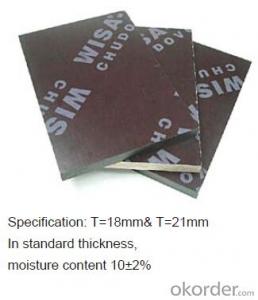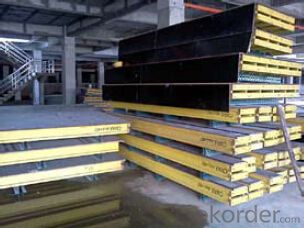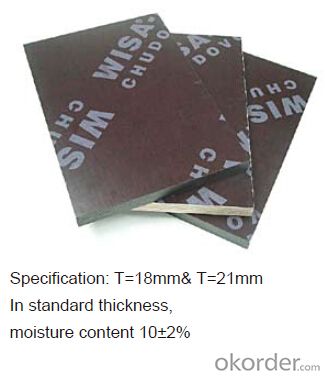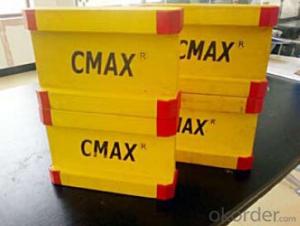Plywood formwork system and scaffolding system
- Loading Port:
- Tianjin
- Payment Terms:
- TT OR LC
- Min Order Qty:
- 50 g/m²
- Supply Capability:
- 1000 g/m²/month
OKorder Service Pledge
Quality Product, Order Online Tracking, Timely Delivery
OKorder Financial Service
Credit Rating, Credit Services, Credit Purchasing
You Might Also Like
Plywood --- make perfect concrete surface
WISA-Form Birch is a coated special plywood using in the formwork systems where high
requirements are set on the concrete surface and the times of reuses.
With CNBM timber beam & WISA plywood, the formwork is low weight but high load capacity, it is
widely used in construction.
Characteristics:
◆ Component with high standardization.
◆ Assembling in site, flexible application.
◆ Light weight, easy transportation and storage.

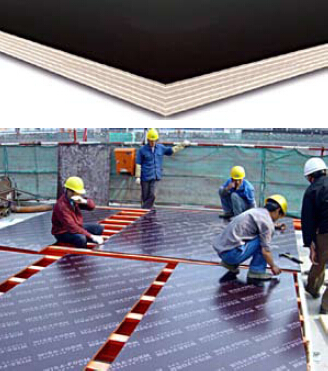
- Q: Can steel formwork be used for architectural concrete finishes?
- Yes, steel formwork can be used for architectural concrete finishes. Steel formwork provides excellent strength, durability, and stability, making it suitable for creating intricate and precise architectural designs. It can be used to achieve smooth, textured, or patterned surfaces for architectural concrete finishes, allowing for a wide range of creative possibilities.
- Q: What are the standard sizes of steel formwork panels?
- The standard sizes of steel formwork panels can vary depending on the specific requirements of the construction project and the manufacturer. However, there are some commonly used standard sizes in the industry. Typically, steel formwork panels come in rectangular shapes with dimensions ranging from 1.2 meters to 2.4 meters in width and 1.8 meters to 3.6 meters in height. These standard sizes are designed to accommodate various construction needs and provide flexibility in forming structures such as walls, columns, slabs, and beams. The thickness of steel formwork panels can also vary, usually ranging from 12mm to 20mm. Thicker panels may be used for heavy-duty applications or to provide additional strength and durability to withstand the pressure exerted by concrete during pouring. It is worth noting that while these are common standard sizes, custom sizes can also be manufactured to meet specific project requirements. Additionally, some manufacturers may offer modular formwork systems that allow for easy assembly and disassembly by combining standard-sized panels in different configurations. Ultimately, the choice of steel formwork panel size depends on factors such as the size and complexity of the structure being formed, the load-bearing capacity required, and the ease of transportation and handling on the construction site.
- Q: How does steel formwork handle concrete surface blemishes?
- Steel formwork is known for its durability and strength, which helps in handling concrete surface blemishes effectively. Due to its rigid structure, steel formwork provides a smooth and even surface for pouring and shaping concrete. This minimizes the occurrence of blemishes such as air pockets, cracks, or unevenness. Additionally, steel formwork offers better control over the pouring and curing process, reducing the chances of surface imperfections. Overall, steel formwork ensures a high-quality finish and helps to minimize concrete surface blemishes.
- Q: Can steel formwork be used for marine construction projects?
- Yes, steel formwork can be used for marine construction projects. Steel has excellent strength and durability, making it suitable for withstanding the harsh marine environment. It offers stability and resistance to corrosion, making it a reliable choice for constructing structures in or near the water.
- Q: Can steel formwork be used for tall structures?
- Yes, steel formwork can be used for tall structures. Steel is a strong and durable material that can withstand the weight and pressure of concrete. It offers the necessary stability and support required for constructing tall buildings and structures. Additionally, steel formwork is versatile, allowing for flexibility in design and construction.
- Q: What are the different types of steel formwork systems available in the market?
- There are several different types of steel formwork systems available in the market, including traditional steel formwork, modular steel formwork, and panelized steel formwork. Traditional steel formwork consists of steel plates or frames that are assembled on-site to create the desired formwork shape. Modular steel formwork is pre-engineered and consists of standardized panels that can be easily assembled and reused. Panelized steel formwork is similar to modular steel formwork but consists of large panels that are interconnected to create the desired formwork shape.
- Q: What is the maximum load capacity of steel formwork?
- The maximum load capacity of steel formwork can vary depending on several factors such as the thickness and quality of the steel, the design of the formwork, and the method of construction. However, in general, steel formwork is known for its high load-bearing capacity and can typically support heavy loads ranging from 50 to 100 kN/m² or even higher, making it suitable for various construction applications.
- Q: Can steel formwork be used for both large and small-scale construction projects?
- Yes, steel formwork can be used for both large and small-scale construction projects. It is a versatile and durable material that can be easily customized and adjusted to accommodate different project sizes and complexities. Steel formwork provides excellent strength and stability, making it suitable for a wide range of construction applications, regardless of the project scale.
- Q: Can steel formwork be used for both interior and exterior concrete structures?
- Yes, steel formwork can be used for both interior and exterior concrete structures. Steel is a versatile material that offers exceptional strength and durability, making it suitable for various construction applications. When used as formwork, steel provides a rigid and stable framework that can withstand the pressure exerted by fresh concrete during pouring and curing. This makes it ideal for creating both interior and exterior concrete structures. Steel formwork is commonly used for constructing walls, columns, beams, slabs, and other structural elements in buildings and infrastructure projects. Its robustness allows it to withstand harsh weather conditions and other environmental factors, making it suitable for exterior structures. Additionally, steel formwork can be easily reused multiple times, which makes it a cost-effective choice for both interior and exterior projects. Furthermore, steel formwork offers flexibility in design and can be easily customized to meet specific project requirements. It can be easily assembled and disassembled, allowing for efficient construction processes. The smooth surface of steel formwork also produces high-quality finishes on concrete structures. However, it is important to note that steel formwork requires proper maintenance to ensure its longevity and prevent corrosion. Regular inspections, cleaning, and the application of protective coatings are necessary to maintain the integrity of the formwork. In conclusion, steel formwork is a versatile and reliable choice for both interior and exterior concrete structures. Its strength, durability, and flexibility make it suitable for a wide range of construction projects, providing efficient and high-quality results.
- Q: Can steel formwork be used for both cast-in-place and precast concrete structures?
- Yes, steel formwork can be used for both cast-in-place and precast concrete structures. Steel formwork is versatile and can be easily adjusted and reused for different projects, making it suitable for both construction methods.
Send your message to us
Plywood formwork system and scaffolding system
- Loading Port:
- Tianjin
- Payment Terms:
- TT OR LC
- Min Order Qty:
- 50 g/m²
- Supply Capability:
- 1000 g/m²/month
OKorder Service Pledge
Quality Product, Order Online Tracking, Timely Delivery
OKorder Financial Service
Credit Rating, Credit Services, Credit Purchasing
Similar products
Hot products
Hot Searches
Related keywords

